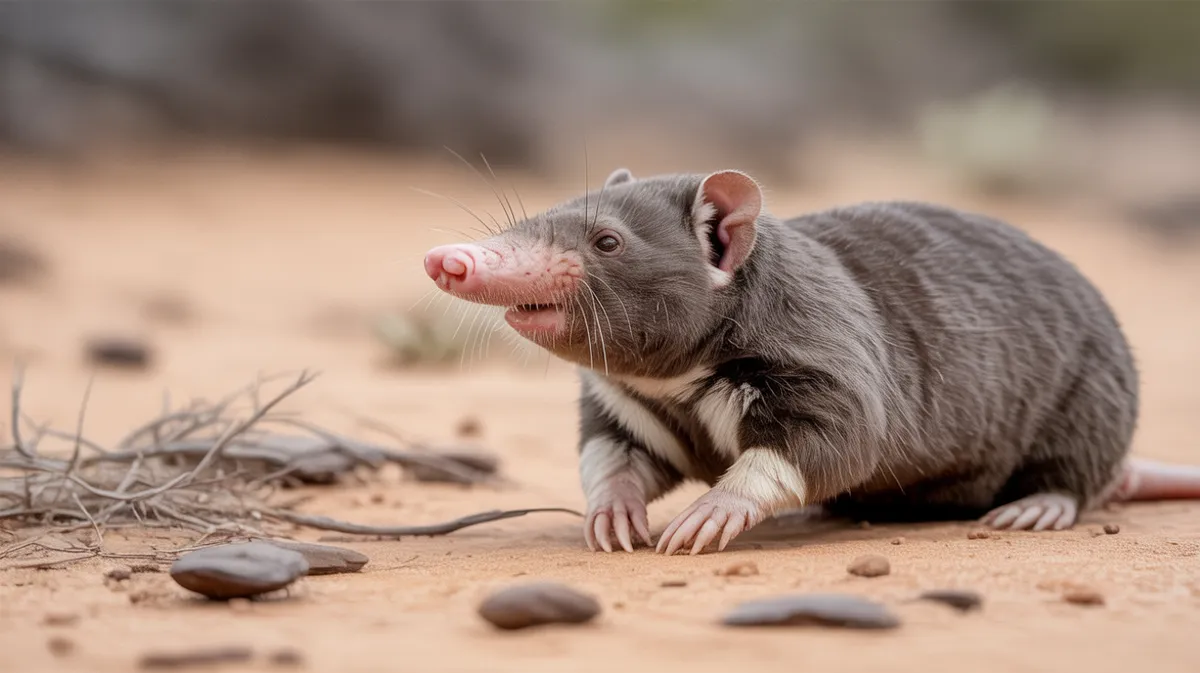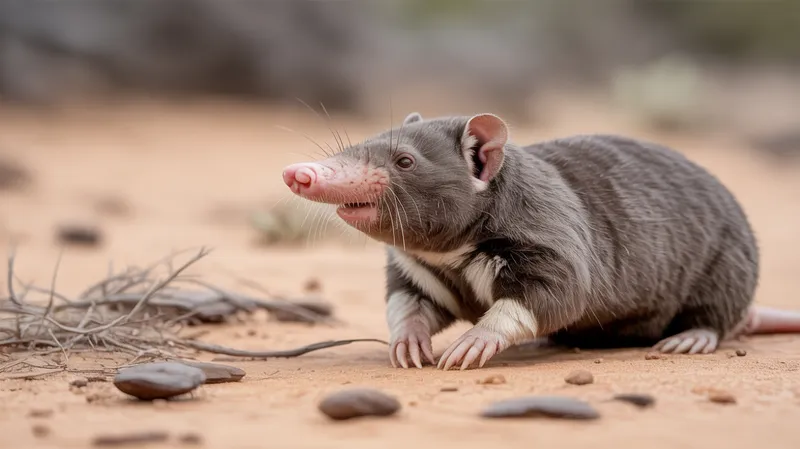
Marsupial Mole
Notoryctes typhlops

Meet the Marsupial Mole
The marsupial mole is a small, burrowing mammal native to the arid interior regions of Australia. Adapted for a life underground, it has velvety golden or creamy fur, reduced eyes covered by skin, and no external ears, making it nearly blind and dependent on touch and smell. Its spade-like forelimbs and streamlined body allow it to efficiently 'swim' through loose sand in search of food. Marsupial moles are elusive and rarely seen, spending almost their entire lives beneath the surface, which makes understanding their behavior and population difficult. They play a unique ecological role in desert habitats, aiding in soil aeration and invertebrate population control.
Classification
Mammal
Habitat
Arid desert and semi-arid sandy regions
Diet
Carnivore
Lifespan
5-7 years
Conservation
Data Deficient
Weight
40-70 grams
📖Fascinating Facts
Backwards Pouch
Unlike most marsupials, the marsupial mole's pouch opens to the rear, preventing sand from filling it while the animal burrows.
Blind Underground
Their eyes are tiny, non-functional, and covered by skin, making them adapted to a life in total darkness.
Desert Specialist
Marsupial moles live in some of the harshest, driest deserts of central and western Australia, rarely emerging above ground.
📋Detailed Description
The marsupial mole (Notoryctes typhlops) is a highly specialized, fossorial marsupial endemic to the arid and semi-arid sandy deserts of central and western Australia. Adults typically measure 12–16 cm in length and weigh between 40–70 grams. Their bodies are cylindrical and streamlined, covered in dense, silky fur that ranges from pale gold to creamy white, minimizing friction as they move through sand. The forelimbs are short and powerfully muscled, each ending in two enlarged, spade-like claws (digits 3 and 4) adapted for efficient digging, while the hind limbs are smaller, with fused toes forming a grooming comb. Marsupial moles lack external ears and possess vestigial, skin-covered eyes, rendering them functionally blind; instead, they rely heavily on tactile and olfactory cues. The snout is leathery and shielded, protecting it during burrowing. Their vertebral column is reinforced, and the neck is short and robust, aiding in head-first sand displacement. The tail is short, naked, and conical, sometimes used as a brace during digging. Marsupial moles spend almost their entire lives underground, rarely surfacing, and are considered one of the most elusive Australian mammals. Their subterranean lifestyle has led to convergent evolution with unrelated placental moles and golden moles, despite their distant ancestry.
💡 Did you know?
Marsupial moles are so adapted to underground life that their eyes are vestigial and covered with skin, making them functionally blind.
🔬Research & Sources
Wikipedia Summary
Marsupial moles, the Notoryctidae family, are two species of highly specialized marsupial mammals that are found in the Australian interior. They are small burrowing marsupials that anatomically converge on fossorial placental mammals, such as extant golden moles (Chrysochloridae) and extinct epoicotheres. The species are:Notoryctes typhlops Notoryctes caurinus
Last Modified: 3/3/2025
🎭Behavior & Social Structure
Marsupial moles are solitary and highly secretive, with most activity occurring beneath the surface in loose, sandy soils. They create temporary, non-permanent tunnels as they 'swim' through sand, collapsing the passage behind them. Their foraging is opportunistic, targeting a variety of subterranean invertebrates such as beetle larvae, ants, termites, and occasionally small vertebrates or plant material. Prey is detected using acute senses of touch and smell, as vision is absent. Marsupial moles exhibit cathemeral activity patterns, being active at irregular intervals throughout the 24-hour cycle, likely influenced by soil moisture and temperature rather than daylight. Surface appearances are rare and often associated with heavy rainfall or disturbances. There is no evidence of territoriality or social groupings; individuals appear to avoid each other except during the breeding season. Communication is poorly understood but may involve tactile or chemical cues.
👶Reproduction & Life Cycle
Reproductive biology in marsupial moles is not fully documented due to their cryptic habits, but they are believed to be polyoestrous, with breeding possibly occurring opportunistically in response to favorable environmental conditions, such as increased food availability after rain. Females possess a rear-opening pouch containing two teats. Litter sizes are typically one or two young. Gestation is estimated at 12–14 days, after which altricial young attach to the teats in the pouch for several weeks. Once sufficiently developed, juveniles leave the pouch but may remain in a burrow for a short period before becoming fully independent. There is no evidence of extended parental care beyond weaning. Sexual maturity is reached within the first year, but lifespan in the wild is unknown, with estimates ranging from 2–4 years.
🛡️Adaptations & Survival
Marsupial moles display a suite of remarkable adaptations for a subterranean existence. Their compact, fusiform bodies and reduced external appendages minimize drag in sand. The spade-like foreclaws and reinforced pectoral girdle enable powerful digging. The skin-covered, vestigial eyes and lack of external ears reduce injury and sand ingress. Dense, silky fur repels sand and insulates against temperature extremes. The backward-opening pouch prevents sand from entering and protects developing young. Their metabolism is adapted for low-oxygen environments, and they can tolerate high levels of carbon dioxide. The conical tail and fused hind toes assist in grooming and sand removal. Sensory adaptations include hypertrophied vibrissae and an enlarged olfactory bulb, compensating for the loss of vision.
📚Research Sources
🎨Cultural Significance
Marsupial moles hold significance in the traditional knowledge and mythology of several Indigenous Australian groups, who recognize them as unique desert dwellers. In some Aboriginal languages, they are known as 'kakarratul' or 'itjaritjari.' Their elusive nature and subterranean habits have contributed to their mystique, and they occasionally feature in Dreamtime stories as creatures of transformation or as symbols of adaptation to harsh environments. There is no evidence of widespread traditional use for food or materials, likely due to their rarity and secretive habits.
🔬Recent Research & Discoveries
Recent advances in molecular genetics have clarified the evolutionary relationships of marsupial moles, confirming their distinct lineage within Marsupialia and their convergent evolution with placental moles. Field studies using environmental DNA (eDNA) and sand tracking have improved detection rates, though direct observation remains rare. Ongoing research focuses on their physiology, particularly adaptations to hypoxic environments, and their ecological role in soil turnover and invertebrate population control. The Notoryctemorphia order, to which they belong, is now recognized as one of the most morphologically specialized among marsupials. Fossil evidence indicates the lineage dates back at least to the Miocene, suggesting a long history of adaptation to arid environments.
🎥Wildlife Videos

Wildlife - Just Marsupials | Free Documentary Nature
Wildlife - Episode 8: Just Marsupials | Wildlife Documentary Watch 'Wildlife - Episode 9' here: https://youtu.be/cjTapqwpkfg Furry, ...
Free Documentary - Nature

David Attenborough Presents: Tasmania - Weird & Wonderful | Free Documentary Nature
David Attenborough presents: Tasmania - Weird & Wonderful | Wildlife Documentary Watch 'David Attenborough's Ant Mountain' ...
Free Documentary - Nature

Australia’s Cutest but Deadliest Marsupials | 4K Nature Documentary
Meet Australia's Least Known but Fiercest Mini Predators! It was a dreadful case of mistaken identity. When European explorers ...
Terra Mater

Marsupial Mole Facts: NOT Really a "Mole" 🐭 Animal Fact Files
The marsupial mole is a mole in name, but this marsupial mammal is not really a mole! Learn more marsupial mole facts on this ...
Animal Fact Files

The Bizarre Origin of Marsupial Moles
Aussie researchers have made a new discovery about the little-known Marsupial Mole (who was famously robbed of the ...
The Project

David Attenborough's | Tasmania | Weird and Wonderful
Attenborough narrates the story of a vast island wilderness - ancient forests, pristine rivers and spectacular coastline. Seasons ...
symmetry
🌍Habitat Information
The Marsupial Mole typically inhabits Arid desert and semi-arid sandy regions environments. Marsupial Moles have adapted to their environments with specialized features and behaviors.
Primary Habitat:
Arid desert and semi-arid sandy regions
More detailed habitat information will be available soon.
🛡️Conservation Status
The Marsupial Mole is currently classified as Data Deficient. Conservation efforts are crucial for preserving this species for future generations.
Common Threats:
- 🏠Habitat loss and fragmentation
- 🌡️Climate change impacts
- 🎯Hunting and poaching
- 🏭Human-wildlife conflict
⚠️Threats & Conservation Challenges
Marsupial moles are classified as Data Deficient by the IUCN due to the scarcity of reliable population data. Their cryptic lifestyle makes monitoring challenging. Potential threats include habitat degradation from mining, off-road vehicles, and altered fire regimes. Predation by introduced species such as feral cats and foxes may also impact populations, though the extent is unclear. Climate change poses a long-term threat by altering rainfall patterns and sand stability. Despite these risks, their remote habitat offers some protection from direct human encroachment. Conservation efforts are hampered by the lack of ecological data and the difficulty of in situ studies.
🔬Scientific Classification
Scientific Name
Notoryctes typhlops
Classification Hierarchy
🔍 About Taxonomic Classification
Taxonomic classification is a hierarchical system used by scientists to classify and organize living organisms based on shared characteristics and evolutionary relationships.
The system moves from broad categories (Kingdom) to increasingly specific ones, with each animal's scientific name typically consisting of its Genus and species.
📝Community Notes
Share your observations and insights about the Marsupial Mole with our community of wildlife enthusiasts.
Join Our Community
Sign in to share your observations and connect with fellow wildlife enthusiasts.
Sign In to ContributeNo community notes yet
Be the first to share your observations about the Marsupial Mole!
Explore Marsupial Mole
Select a tab above to learn more about this amazing animal.
📸Photo Gallery
No photos available for this animal yet.
🌟Discover More Wildlife
Continue your journey of discovery with more fascinating animals from our database
